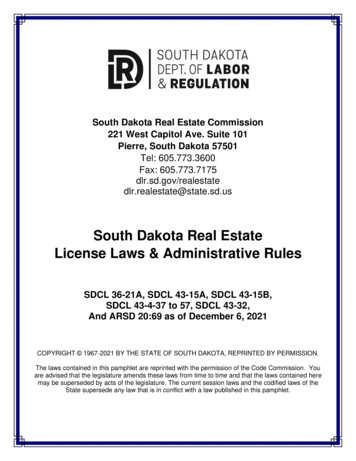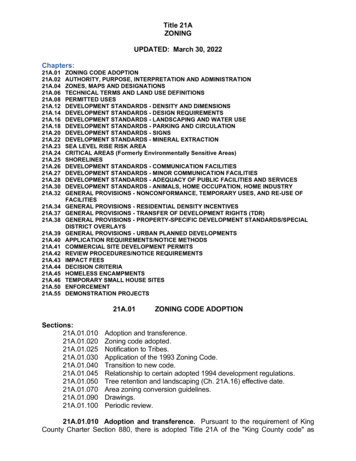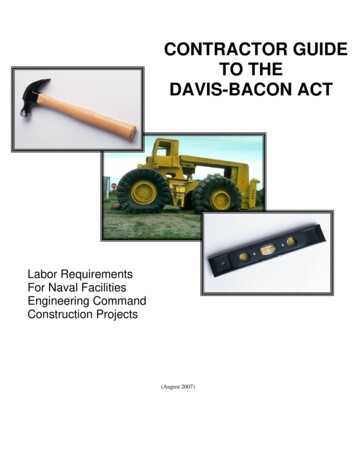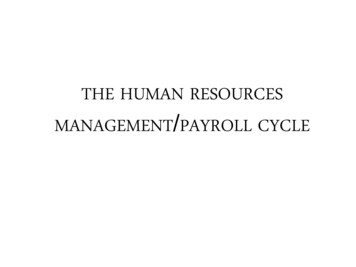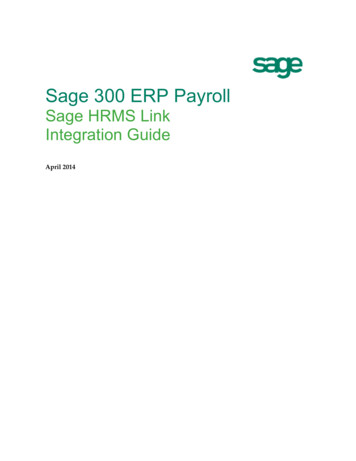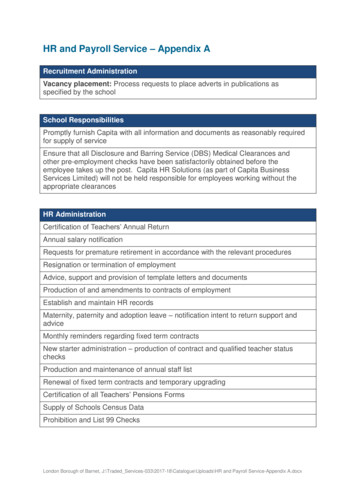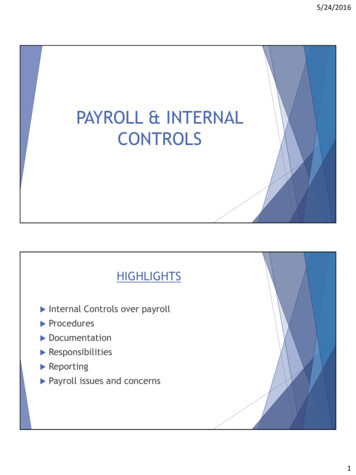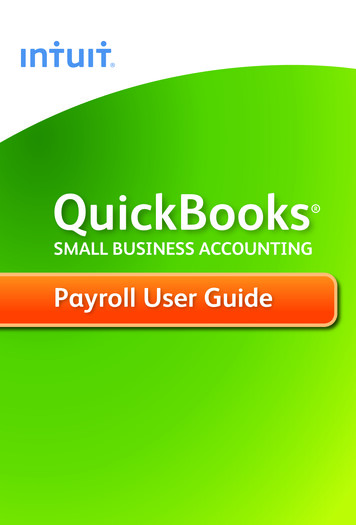
Transcription
Pennsylvania Housing Finance Agency211 North Front StreetHarrisburg, PA 17101Certified Payroll Report Form RequirementsWhy you need to fill out:On HUD projects, certain laws and regulations related to labor must be applied. The Davis Bacon Act requires thepayment of prevailing wage rates determined by the Department of Labor to all labors and mechanics on Federalgovernment projects in excess of 2,000.00. The Copeland Act requires that each week every employer must submitweekly payroll reports called certified payroll reports (CPR’s)You will be provided with one set of necessary HUD forms for the project including the certified payroll report and HUDstart up forms.Certified Payroll Report Form:Certified Payroll Report Forms must be filled out for each week of work by either an authorized company officer or aperson appointed by the authorized officer until you are completely finished with the project. The “Payroll AuthorizationLetter: Certificate from Contractor Appointing Officer or Employee to Supervise Certified Payroll Payments” must befilled out and returned.Each payroll week must be numbered consecutively. The first payroll should be marked “1 - INITIAL” followed by Payroll2 then Payroll 3, and so on. The last payroll must be marked with the next number in the sequence along with “FINAL”.Weeks where no work is performed onsite still require submitting a certified payroll report form with “NO WORKPERFORMED” written across the payroll OR use the alternative option of submitting a “No Work” Report Form.Payroll submissions must be mailed or dropped off at the General Contractor’s office. Faxing is not accepted. As ageneral rule, payrolls should be submitted to the General Contractor on Wednesday for the previous work week.Payrolls must be signed by a company officer or an appointed employee to be considered valid. Only original signaturesin BLUE INK are accepted, as signatures in black ink can often look like a copy.Payment of employees, by law must be at least the prevailing wage rate listed on the wage determination for each tradeclassification. A copy of the wage determination can be obtained from the General Contractor or found in the Bid SpecDocuments. If your work classification does not appear on the wage determination, please contact PHFA ComplianceOfficer.For further assistance, you are provided with HUD’s Guide to Filling Out Certified Payroll Report Forms, and the DavisBacon Labor Standards: A Contractor’s Guide to Prevailing Wage Requirements for Federally-Assisted Construction.Payroll Support Forms1. Payroll Authorization Letter - If a Corporate Officer/Owner is not the one signing the Certified Payroll ReportForms and “No Work” Report Forms, then this form must be completed for any individual that is beingauthorized to sign the forms.2. “No Work” Report Form - These reports must be completed and submitted for any week that you have noemployees participating onsite.Rev. 7/181 of 10
3. Fringe Benefits Form - This form must be completed if you are paying an employee less than the set prevailingwage rate amount. This form must be submitted with each weekly Certified Payroll Report Form.4. “Other” Deductions Form - This form must be completed if you have a deduction amount appearing on theCertified Payroll Report Form (WH-347) under the “Other” column. This form must be submitted with eachweekly Certified Payroll Report Form.5. Employee Authorization of Payroll Deductions Letter - This form must be completed by any of your employeesthat are working on this project that have any deductions that you will put on the Certified Payroll Report Form(WH-347) in Column 8 Deductions under the column “Other”.6. Employee Listing Form - If you provide an employee listing (include employees who will work on this project)which includes each employee’s name, address and social security number with the first certified payroll, thenyou only have to place the employee’s name and last 4 digits of the social security number on the CertifiedPayroll Report Form (WH-347) that you send in every week. If an employee listing is not provided, then youmust put each employee’s name, address and social security number on each Certified Payroll Report Form(WH-347) each week.HUD’s Guide to Filling Out Certified Payroll Report FormsHeading of Payroll:1. State name of Employer and whether he is a contractor or subcontractor.2. Print Employer’s IRS Identification Number on the first payroll.3. Show complete address.4. Show payroll number.5. Show date for the last day of the 7 day period.6. Show project name and location.7. Show project or contract number.Employee Information:1. Column 1 – Name of employee with last four digits of his/her social security #.2. Column 2 – Number of exemptions is optional.3. Column 3 – Consult wage determination to determine the official title of employee. If the worker is anapprentice, state both his current step and percentage.a. Split Classifications (i.e. a man who works during a single week as both an electrician and a carpenter,etc.)b. Should be shown on separate lines4. Column 4 – List the days and dates worked. List the total straight time hours (S) and overtime hours (O)separately.5. Column 5 – List the total project hours only.6. Column 6 – Rate of pay cannot be less than that set forward in the wage determination. Overtime must be paidat no less than one and one-half times the regular rate of basic pay plus the straight-time rate of any requiredfringe benefits – overtime is paid for any hours in excess of 40 hours in a week.7. Column 7 – Show the gross amount earned on this project separately from gross amount on all projects by asplit entry (i.e. 123.45/ 678.90 – the top line is for this project and the bottom line is the gross earnings for theemployee’s entire week’s pay).Rev. 7/182 of 10
8. Column 8 – Show the employee’s total deductions for the week (just as it shows on his/her pay stub) – do notbreak out the project deductions. Any deduction listed in the “other” column must be explained in full on thereverse side of the payroll report or on an “Other Deductions” Form. Any deductions not considered a standarddeduction by DOL must be accompanied by a “Payroll Deduction Authorization” Form signed by the employeegiving authorization to make said deductions (i.e. tools, personal cell phone use, etc.).9. Column 9 – Show total net wages paid for the week (just as it shows on his/her pay stub).Back of Payroll:1. Check either 4a or 4b. 4a. means funds are paid into authorized fringe benefit plans. 4b means all funds are paidin cash to the employees. Show exceptions in 4c.2. Payroll bears the original signature of an officer of the firm or a person so authorized.3. All information requested has been supplied.Permissible Payroll DeductionsA. Any deduction made in compliance with the requirements of Federal, State, or Local Law.Examples: Federal withholding taxesState withholding taxesFederal Social Security taxesB. Any deductions of sums previously paid to the employee as a bona fide prepayment of wages when prepaymentis made without discount or interest.Examples: A “bona fide prepayment of wages” is considered to have been made only when cash or itsequivalent has been advanced to the person employed in such manner as to give him completefreedom of disposition of advanced funds.C. Any deduction of amounts required by court process to be paid to another, unless the deduction is in favor of. The contractor The subcontractor Any affiliated personOR When collusion or collaboration existsD. Any deduction constituting a contribution on behalf of the person employed to funds established by theemployer, or representative of the employer, or both for the purpose of providing (from principle, or income, orboth) . Medical or hospital care Pensions or annuities on retirement Death benefits Compensation for injuries, illness, accidents, sickness, or disabilityOR For insurance for any of the foregoing Unemployment benefits Vacation pay Savings accounts Similar payments for the benefit of employees, their families and dependents, as long as . . . The deduction is not otherwise prohibited by law It is .Rev. 7/183 of 10
1. Voluntarily consented to by the employee in writing and in advance of the period in which the workis to be done.ANDSuch consent is not a condition either for the obtaining of or for the continuation of employment.OR2. Provided for in a bona fide collective bargaining agreement between the contractor orsubcontractor and representatives of its employees. No profit or other benefit is otherwise obtained, directly or indirectly, by the contractor orsubcontractor or any affiliated person in the form of commission, dividend, or otherwise; and The deductions shall serve the convenience and interest of employees.Fringe BenefitsDefinition: (29 CFR 5.2(p)):The term “wages” means: The basic hourly rate of pay. Any contribution irrevocably made by a contractor or subcontractor to a trustee or third partypursuant to a bona fide fringe benefit fund, plan or program. The rate of costs to the contractor or subcontractor which may be reasonably anticipated inproviding bona fide fringe benefits pursuant to an enforceable commitment to carry out a financiallyresponsible plan or program, which was communicated to the employees in writing.The statutory language regarding fringe benefits is in section 1(b)(2)(b) of the Davis Bacon Act, and is reiteratedat 29 CFR 5.23.In practice:The Davis-Bacon “prevailing wage” is made up of two interchangeable components-a basic hourly wage andfringe benefits. Along with the basic hourly rate listed on the wage determination, a fringe benefit will be listedfor any classification for which fringe benefits were found prevailing. The total, including any fringe benefitslisted comprises the “prevailing wage” requirement. This obligation may be met by any combination of cash wages and creditable “bona fide” fringe benefitsprovided by the employer: The total, including any fringe benefits listed for the classification, may be paid entirely as cashwages; Payments made or costs incurred by the contractor for “bona fide” fringe benefits may be creditabletowards fulfilling the requirement; or A combination of cash wages paid and “bona fide” fringe benefits may be used together to meet thetotal required prevailing wage.Rev. 7/184 of 10
Example:A Davis-Bacon wage determination requires:Basic Hourly Rate: 10.00Fringe Benefit Rate: 1.00Total Prevailing Rate: 11.00The contractor can comply by paying:1. 11.00 in cash wages;2. 10.00 plus 1.00 in pension contributions or other “bona fide” fringe benefits; or3. 9.00 plus 2.00 in pension contributions or any combination of “bona fide” fringe benefits.Note: Under DBA/DBRA (unlike SCA) monetary wages paid in excess of the basic hourly rate may beused as an offset or credit to satisfy fringe benefit obligations, and vice versa. (If fringe benefitcontributions are credited towards fulfilling the basic hourly rate requirement in the wagedetermination, at least the basic hourly rate listed in the contract wage determination must be used incomputing overtime pay obligations.)Please provide to our office proof of how your company offers fringe benefits to your employees. At aminimum, this proof must be provided one time per project for each employee and should be submittedwith the certified payrolls. If you are unable to provide proof via certified payroll a separate worksheetshould be submitted (sample copy attached).Application to all hours worked:Under Davis-Bacon, fringe benefits must be paid for all hours worked, including the overtime hours.However, the fringe benefit amounts may be excluded from the half-time premium due as overtimecompensation.For example:An employee worked 44 hours as an electrician. The wage determination rate was 12.00 (basic hourlyrate) plus 2.50 in fringe benefits. He would be due:Straight Time Pay: 44 Hours x ( 12.00 2.50) 638.00Overtime Pay: 4 Hours x (½ x 12.00) 24.00 662.00Crediting fringe benefit contributions to meet DBA/DBRA requirements:The Davis-Bacon Act (and 29 CFR 5.23), list fringe benefits to be considered.Examples: Rev. 7/18Life insuranceHealth insurancePensionVacation5 of 10
HolidaysSick leaveThe use of truck is not a fringe benefit; a Thanksgiving turkey or Christmas bonus is not a fringebenefit. (See Cody-Zeigler, Inc., WAB Case No. 89-19, April 30, 1991.)No credit may be taken for any benefit required by federal state or local law, such as: Workers compensationUnemployment compensationSocial security contributionsHealth benefits required under Hawaii state lawFunded fringe benefit plans: The contractor’s fringe benefit contributions made irrevocably to a trustee or third party pursuant to afund, plan or program, can be credited toward meeting the prevailing wage requirement, without priorDOL approval. For example: Contractor pays for health insurance monthly premiums without employee contributions.(Where payroll deductions for employee contributions are involved, additional rules apply). Contractor makes quarterly contributions to retirement plan trust. The amount of contributions for fringe benefits must be paid irrevocably to the trustee or thirdparty. Contributions to fringe benefit plans must be made regularly, not less often than quarterly. [Thisrequirement is specified in the standard Davis-Bacon Contract clauses at 29 CFR 5.5(a)(1)(i)]. Annual contributions into a plan do not meet this requirement. While profit sharing plansare bona fide within the meaning of the Act, profits are not determined until the end ofthe year. Therefore, the DOL requires contractors to escrow money at least quarterly onthe basis of what the profit is expected to be. The contractor must make payments or incur costs in the amount specified by the applicablewage decision with respect to each individual laborer or mechanic. Thus, the amountcontributed for each employee must be determined separately, and credit can be takenaccordingly towards the prevailing wage requirement for each individual. (It is not permissible totake credit based on the average premium paid or average contribution made per employee.) Credit may not be taken for fringe benefit contributions made on behalf of employees who arenot eligible to participate in the plan (e.g., those excluded due to age or part-time employment). Some plans provide that contributions and allocations under the plan will only be made onbehalf of participants who are employed on the last day of the plan year. No credit ispermitted for such participants for whom no contribution is made or for contributionsmade for employees whose accounts receive no allocation solely because they are notemployed on the last day of the plan year. On the other hand, it is not required that all employees participating in a fringe benefitplan be entitled to receive benefits from the plan at all times. For example, an employeewho is eligible to participate in an insurance plan may be prohibited from receivingRev. 7/186 of 10
benefits from the plan during a 30-day waiting period. Contributions made on behalf ofthese employees would be creditable against the contractor’s fringe benefit obligations. A pension plan that meets the Employment Retirement Income Security Act (ERISA)requirements may be considered “bona fide” for DBA /DBRA purposes. Some pension plans contain “vesting” requirements. Where an employer contributes to theplan, employees may be required to complete a certain length of service before they have anon-forfeitable right to benefits based on the employer’s contributions to the plan.Thus, an employee who leaves employment before completing the specified length of servicemay forfeit all or part of the accrued benefit. Such forfeitures are permitted, provided the plan isa bona fide plan that meets applicable requirements under ERISA, including minimum vestingrequirements. Forfeited Davis-Bacon contributions may not revert to the employer, but shouldbe distributed among the remaining plan participants.Unfunded plans: A fringe benefit plan or program under which the cost a contractor may reasonably anticipate inproviding benefits that will be paid from the general assets of the contractor (rather thanfunded by payments to a trustee or third party) is generally referred to as an unfunded plan.These generally include: Holiday plans Vacation plans Sick pay plans No type of fringe benefit is eligible for consideration as an unfunded plan unless it meets thefollowing criteria:1. It can be reasonably anticipated to provide benefits described in the Davis-Bacon Act;2. It represents a commitment that can be legally enforced;3. It is carried out under a financially responsible plan or program; and4. The plan or program has been communicated in writing to the laborers and mechanicsaffected.Annualization: To insure that such plans are not used to avoid compliance with the Act, the Secretary of Labordirects the contractor to set aside, in an account, sufficient assets to meet the future obligationof the plan. Davis-Bacon credit for contributions made to fringe benefit plans are allowed based on theeffective annual rate of contributions for all hours worked during the year by an employee,regardless of whether or not the hours were worked on a Davis-Bacon project.Examples: Rev. 7/18For a defined benefit pension plan, or for a defined contribution pension plan which doesnot provide for immediate or essentially immediate vesting, if a contractor wishes toreceive 2.00 per hour credit for a pension contribution, the contractor must contribute at7 of 10
this same rate for all hours worked during the year. If this is not done, the credit for DavisBacon purposes would have to be revised accordingly.If the firm’s contribution for the pension benefit was computed to be 2,000.00 a year fora particular employee, the employee worked 1,500 hours of the year on a Davis-Baconcovered project and 500 hours of the year on other jobs not covered by the Davis-Baconprovisions, only 1,500.00 or 1.00 per hour would be creditable towards meeting thefirm’s obligation to pay the prevailing wage on the Davis-Bacon project. (Annualcontribution: 2,000.00, divided by total hours worked: 1,500 500 2000; i.e. 2,000.00 2000 hours 1.00 per hour.) For contributions made to defined contribution pension plans which provide for immediateparticipate and immediate or essentially immediate vesting schedules (100% vesting after anemployee works 500 or fewer hours), and also certain supplemental unemployment benefitplans, a contractor may take Davis-Bacon credit at the hourly rate specified by the plan. Undersuch plans, contributions are irrevocably made by the contractor, most, if not at all, of theworkers will become fully vested in the plan, and the higher contributions made during DavisBacon work result in an increase in the value of the individual employee’s account. The amountof contributions to such plans should be in conformance with any limitations imposed by theInternal Revenue Code.Example:An employee works as an electrician where the wage determination rate is 12.00 (basichourly rate) plus 2.50 in fringe benefits. Where the employer provides the electrician with medical insurance in the amount of 200.00 per month ( 2,400.00 per year), the employer would divide the total annualcost of the benefit by 2,080 hours (40 hours x 52 weeks) to arrive at the allowable fringebenefit credit.( 200.00 x 12 Months) 2080 Hours 1.15 per Hour. If the employee in this example receives no other “bona fide” fringe benefits, then foreach hour worked on a covered contract the individual is due 12.00 (basic hourly rate)plus 1.35 paid as cash (the difference between the 2.50 per hour fringe benefitrequired under the applicable wage determination and the credit allowed for theprovision of medical insurance.) Thus,Basic Hourly Rate:Medical Insurance Benefit:Additional Cash Due:Total Due per Hour:Rev. 7/18 12.00 1.15 1.35 14.50 ( 12.00 2.50)8 of 10
Crediting Fringe Benefits for Davis Bacon Covered Work:EXAMPLE - METHOD 1Mike's Plumbing Company, LLCEIN# sionBC/BSPlumber 680.00 1,088.00 0.00Unskilled LBR 1,040.00 832.00Unskilled LBR 0.00PlumberTotalFringesPlusWagesPaidFringeTotal PerYearFringeHourlyWagePaid 2,559.60 4,327.60 2.08 20.03 22.11 0.00 313.20 2,559.60 4,744.62 2.29 14.00 16.29 0.00 64.00 0.00 0.00 64.00 0.03 12.46 12.49 0.00 1,600.00 1,280.00 663.46 2,559.60 6,103.06 2.94 20.03 22.97 0.00Unskilled LBR 400.00 800.00 0.00 2,559.60 3,759.60 1.81 13.60 15.41 0.00Unskilled LBR 400.00 800.00 412.91 2,559.60 4,172.51 2.01 14.70 16.01 0.00Plumber 1,680.00 1,344.00 825.03 2,559.60 6,408.63 3.09 21.00 24.09 0.00Unskilled LBR 0.00 960.00 0.00 2,559.60 3,519.60 1.70 16.00 17.70 0.00Plumber 640.00 1,024.00 0.00 2,559.60 4,223.60 2.03 20.03 22.06 0.00Unskilled LBR 1,280.00 1,024.00 566.98 2,559.60 5,430.58 2.61 16.00 18.61 0.00OwedOther Approved Fringe Benefits: Training & Education52 Weeks x 40 Hours per Week 2080 Hours per YearRev. 7/189 of 10
EXAMPLE – METHOD 2 Wage determination states a particular classification of work is due 17.60 per hour base rate plus 7.65 fringebenefits rate for all hours worked in that classification on the DB covered contract. Thus the employer has a total 25.25 per hour obligation to be paid.The employer provides a variety of fringe benefits which are creditable towards the Davis Bacon obligation. Theyinclude:Employer Monthly Share of Health InsuranceEmployer Contributions to Life InsuranceEmployer Contributions to 401KVacation: Employer Cost for 2 Weeks of Paid Vacations per Year at the Regular Shop Rate ( 12.00 per Hour)Holidays: Employer Cost for 6 Days of Paid Holidays per Year at the Regular Shop Rate ( 12.00 per Hour)Employer may calculate the hourly credit to be taken for these fringe benefits by a process of “annualization”. Firsttake the annual costs of all the fringes:Employer Monthly Share of Health Insurance 225 Paid per Month x 12 Months 2,700.00Employer Contributions to Monthly Life Insurance 50.00 x 12 Months 600.00Employer Contributions to 401K over the Year 1,735.00Vacation80 Hours x 12.00 per Hour Shop Rate 960.00Holidays48 Hours x 12.00 per Hour Shop Rate 576.00Total Value of Fringe Benefits for the Year 6,571.00 Next take all hours (government and non-government) worked by the employee over the past year, let’s say 1,735hours, and divide it into the total fringes amount. 6,571.00 1,735 Hours 3.79 per Hour 3.79 per hour is the amount of fringe credit that can be taken for each hour worked on the Davis Bacon coveredproject. Thus 25.25 - 3.79 21.46, which is the remaining cash wage that must be paid in full.Rev. 7/1810 of 10
Rev. 7/18 2 of 10 3. Fringe Benefits Form - This form must be completed if you are paying an employee less than the set prevailing wage rate amount. This form must be submitted with each weekly Certified Payroll Report Form. 4. "Other" Deductions Form - This form must be completed if you have a deduction amount appearing on the Certified Payroll Report Form (WH-347) under the "Other .
